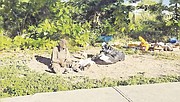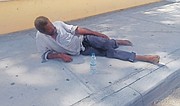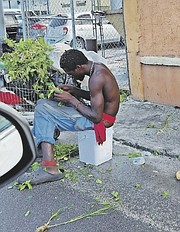WE see them every day, the street people of Nassau. We glance at them, wonder for a moment how they wound up living where they are, like they are. We are not necessarily critical. No one can get into someone else’s head, not even into the thoughts of those closest to us so how are we to understand what makes a person tick who decides to call a plot of land under the canopy of a tree or a piece of pavement between a fuel station and a marine supplies store home?
Mostly, we see, but don’t dwell on the street people of Nassau because, lacking understanding, we move on mentally past the sight of them quickly, getting on with our own lives for fear if we don’t keep up we will become yesterday’s unused loaf of bread – stale and dry and of no value.
So in our rush, we leave those who choose to live in the bush in the condition we see them in.
Those who carry an extra bag of dog food in their car to feed a stray they see by the side of the road may pass the human next to the dog and not stop to think that dog food is sometimes his best meal of the day.
I know little about these people. I am fascinated by those among them who have the ability to sleep on the top of a wall without falling off. Clearly they have skills way beyond mine.
Here’s what I do know: law enforcement knows who they are and rarely messes with them unless they are in such a public place that they interfere with the visitor experience or traffic as the man in the wheelchair zigzagging across a busy intersection on Nassau Street did. When they land in the wrong neighbourhood, it takes a little while but law enforcement moves them along. Hygiene or lack thereof makes them in the minds of most police the untouchables and so long as the only person they may be harming is themselves, the law is satisfied leaving them right where they are.
Here’s what else I know: many of them know each other and look out for each other in odd ways. They know the routines, what days The Salvation Army is serving a hot meal and a prayer.
Or when to stand in line at Great Commission Ministries. Or how to appeal to the compassionate heart of Rev. CB Moss at Mt. Olive Baptist Church in Bain Town. They may not know that the Bahamas Feeding Network is providing the food for nearly 100 churches and feeding centres like these, but they surely know what church or centre is serving on what day. They are a small minority of those who receive, but they are among the most dependent on what is provided.
And I know this: Many of the street people choose to be where they are, fearing or not wanting to be ‘trapped’ by family or an enclosed environment. Inside scares them more than outside.
They may have been to a home or to Sandilands or served a sentence and confinement is far worse than a little rain falling on their blanket. They also know how to take cover under the eave of a building when a storm approaches, moving a few feet or a block down the street is part of the routine, a different version of a second home in The Bahamas.
Many of the street people know each other and there is an underground whisper that grows louder when someone is ill, needs something, or passes along. Try a breakfast offer like Rotary of East Nassau did, put out the first hot dish and in minutes, nearly 100 show up. A message spread without a cellphone, a cyberspaceless social media channel of its own.
Just last week, a BBC report delved into the hidden talents of the homeless, finding artists and poets and others with great minds in those who call a park bench or a bush home. I don’t doubt that the same exists among the street people of Nassau.
We may never know. As I said at the start of these few words, we see them. We pass by. We are rushing to keep our lives on track, not bothering to wonder how their lives fell off. I never called them homeless. They have made a home even if it is not the kind of home we call home. I do think we can do better by them, dropping off warm clothes as the weather changes, or a bit of food, but mostly by recognizing the simple fact that we will never understand who they are, what drove them to call a piece of pavement or a patch of worn grass home, but they are survivors. And for that, they are amazing. We do not have to understand what makes them tick but if survival of the fittest is truly survival of the most adaptable, the street people of Nassau deserve a second look. Perhaps an artist will capture them or a mural competition will feature them and some day we may know more but for now it is okay if we don’t. We are busy getting on with those lives of our own.









Comments
Use the comment form below to begin a discussion about this content.
Sign in to comment
Or login with:
OpenID